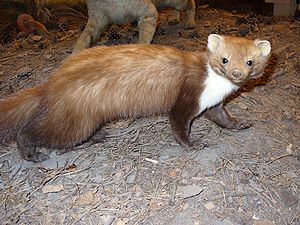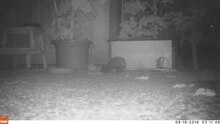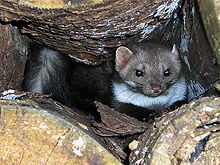Beech marten
| Beech marten | ||||||||||||
|---|---|---|---|---|---|---|---|---|---|---|---|---|

Beech marten ( Martes foina ) (preparation) |
||||||||||||
| Systematics | ||||||||||||
|
||||||||||||
| Scientific name | ||||||||||||
| Martes foina | ||||||||||||
| ( Erxleben , 1777) |
The stone marten ( Martes foina ), sometimes also called house marten , is a species of predator from the marten family (Mustelidae). It is the most common species of the genus of the real marten in Central Europe and is regularly found in the vicinity of humans as a cultural follower. The so-called "car martens" occasionally mentioned in the press are usually stone martens.
description
Stone martens have the usual build for martens with an elongated, slender trunk and relatively short limbs. The tail is relatively long and bushy. From the second species of real marten that lives in Central Europe, the pine marten, it differs externally in the shape and color of the throat spot.

In the stone marten, this is white and often forked and can extend to the front legs, while in the pine marten it is yellowish and rounded. However, in some Asian populations, the throat patch can be completely absent. The fur of these animals is gray-brown in color and rough.
Further differences to the pine marten are the light-colored nose and the hairless soles of the feet. The stone marten is also a bit shorter, but heavier than its relative. The animals reach a head body length of 40 to 54 centimeters, a tail length of 22 to 30 centimeters and a weight of 1.1 to 2.3 kilograms.
distribution and habitat
Beech martens are native to large parts of Eurasia . Their range extends from Spain over Central and Southern Europe (including some Mediterranean islands) and Central Asia to the Mongolia and the Himalayan region. A population introduced for fur hunting has also established itself in the US state of Wisconsin .
As the only representative among the real marten , the stone marten is not a real forest dweller. It prefers more open, bush or tree-covered and often rocky terrain and can be found in mountains up to 4000 meters above sea level. As a cultural follower , he can often be seen in the vicinity of human settlements, where he stays in parks, barns or in attics, which is why he is also called roof marten or house marten.
Apparently the stone marten came to the Iberian Peninsula after the pine marten. The stone marten apparently benefited from the neolithization of the peninsula, while the pine marten was pushed to the north of the peninsula.
Way of life
Stone marten are primarily nocturnal, during the day they retreat to hiding. Natural hiding places include crevices in the rocks, stone piles or abandoned burrows of other animals (they do not dig burrows themselves), but they often retreat to buildings in attics or stables. The nests are padded with hair, feathers or plant material. At night the stone marten searches for food, mainly moving on the ground. Although he can climb well, he rarely climbs higher up trees.
Like most martens, beech martens are solitary animals who avoid contact with their own species outside of the mating season. They are territorial animals that mark their territory with the secretion of scent glands and at least defend it against same-sex stone marten. The territory size is variable, but smaller than that of the pine marten ; their range is between 12 and 210 hectares and depends, among other things, on gender - males have larger territories than females - as well as the season (smaller in winter than in summer) and the food available.
food
Beech marten are opportunistic omnivores , but they mainly eat meat. They prey on small mammals (for example rodents and rabbits ), birds and their eggs, frogs , insects and others. In summer, plant material, especially berries and fruits, is an important part of the diet. Sometimes they also invade chicken coops and dovecotes. The birds' panic fluttering around triggers their killing reflex again and again, so that they kill all of the animals in it, even if they cannot eat all of them.
Reproduction
The mating takes place in summer (June to August), but due to the dormancy the females only give birth in spring (March or April). There are eight months between mating and birth, but the actual gestation period is only one month. The litter size is usually three to four, the newborns are blind and naked. After a month they open their eyes, after two months they are weaned, in the fall they become independent. Sexual maturity occurs between the ages of 15 and 27 months. The average life expectancy in the wild is three years, the maximum age is ten years. In human care they can get significantly older, up to 18 years.
Beech martens and people
Stone marten were sometimes hunted for their fur, but to a far lesser extent than pine marten , for example , as their fur is considered less valuable.
They are also tracked as “ pests ” that invade bird houses or rabbit enclosures.
Stone martens are known to bite through cables, hoses and insulation material in vehicles and thus cause considerable damage - in this context they are often referred to as "car martens". The reasons for this are not, as is often assumed, the residual heat of the engine or the smell that attracts the animals. Territory markings by conspecifics in the engine compartment are probably mainly responsible for the stone martens' interest in cars. In other words, it is not the first marten to seek refuge under the car that damages the car, but the next one that the opponent's smell makes aggressive. A number of aids are offered to ward off martens . In 2017, the insurance companies in Germany reported 214,000 damage caused by marten bites.
The tendency of stone marten to move into buildings, especially attics, can also bring them into conflict with humans.
Stone marten are subject to hunting rights and are quite common in a large part of their range, they are not endangered species.
literature
- Beate Ludwig: Of martens and people. The book of the stone marten. 2nd edition, Tecklenborg Verlag, Steinfurt 1999, ISBN 3-924044-68-6 .
- Ronald M. Nowak: Walker's Mammals of the World . 6th edition. Johns Hopkins University Press, Baltimore 1999, ISBN 0-8018-5789-9 (English).
- Ilse Haseder , Gerhard Stinglwagner : Knaurs Großes Jagdlexikon , Weltbild Verlag GmbH, Augsburg 2000, ISBN 3-8289-1579-5
Web links
- Martes foina in the endangered Red List species the IUCN 2008. Posted by: A. Tikhonov u. a., 2008. Accessed January 1, 2009. (Eng.)
- Information ( Memento from May 8, 2002 in the Internet Archive ) at forst-hamburg.de
- Marten Information Foundation for Nature Conservation Berlin
- spurenjagd.de : Stone marten - Animal tracks data collection
Individual evidence
- ↑ so in the German dictionary of the Brothers Grimm , entry under house marten
- ↑ Laura Llorente-Rodríguez, Carlos Nores-Quesada, José Antonio López-Sáez, Arturo Morales-Muñiz: Hidden signatures of the Mesolithic – Neolithic transition in Iberia: The pine marten (Martes martes Linnaeus, 1758) and beech marten (Martes foina Erxleben , 1777) from Cova Fosca (Spain) , in: Quaternary International, Jul 2015 (in press).
- ↑ Peer Körner: Marten damage to the car: Industry has cables tested by martens . Spiegel Online , December 11, 2014.
- ↑ Types of damage. Retrieved May 6, 2019 .




